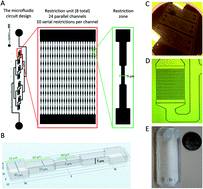Our official English website, www.x-mol.net, welcomes your feedback! (Note: you will need to create a separate account there.)
A microfluidic approach to study the effect of mechanical stress on erythrocytes in sickle cell disease†
Lab on a Chip ( IF 6.1 ) Pub Date : 2018-08-28 00:00:00 , DOI: 10.1039/c8lc00637g Maria Alejandra Lizarralde Iragorri 1, 2, 3, 4, 5 , Sara El Hoss 1, 2, 3, 4, 5 , Valentine Brousse 1, 2, 3, 4, 5 , Sophie D. Lefevre 1, 2, 3, 4, 5 , Michael Dussiot 2, 6, 7, 8, 9 , Tieying Xu 10, 11, 12, 13, 14 , Alexander Rodrigo Ferreira 15, 16, 17 , Yann Lamarre 15, 16, 17 , Ana Cristina Silva Pinto 15, 16, 17 , Simone Kashima 15, 16, 17 , Claudine Lapouméroulie 1, 2, 3, 4, 5 , Dimas Tadeu Covas 15, 16, 17, 18, 19 , Caroline Le Van Kim 1, 2, 3, 4, 5 , Yves Colin 1, 2, 3, 4, 5 , Jacques Elion 1, 2, 3, 4, 5 , Olivier Français 14, 20, 21, 22 , Bruno Le Pioufle 10, 11, 12, 13, 14 , Wassim El Nemer 1, 2, 3, 4, 5
Lab on a Chip ( IF 6.1 ) Pub Date : 2018-08-28 00:00:00 , DOI: 10.1039/c8lc00637g Maria Alejandra Lizarralde Iragorri 1, 2, 3, 4, 5 , Sara El Hoss 1, 2, 3, 4, 5 , Valentine Brousse 1, 2, 3, 4, 5 , Sophie D. Lefevre 1, 2, 3, 4, 5 , Michael Dussiot 2, 6, 7, 8, 9 , Tieying Xu 10, 11, 12, 13, 14 , Alexander Rodrigo Ferreira 15, 16, 17 , Yann Lamarre 15, 16, 17 , Ana Cristina Silva Pinto 15, 16, 17 , Simone Kashima 15, 16, 17 , Claudine Lapouméroulie 1, 2, 3, 4, 5 , Dimas Tadeu Covas 15, 16, 17, 18, 19 , Caroline Le Van Kim 1, 2, 3, 4, 5 , Yves Colin 1, 2, 3, 4, 5 , Jacques Elion 1, 2, 3, 4, 5 , Olivier Français 14, 20, 21, 22 , Bruno Le Pioufle 10, 11, 12, 13, 14 , Wassim El Nemer 1, 2, 3, 4, 5
Affiliation

|
The human red blood cell is a biconcave disc of 6–8 × 2 μm that is highly elastic. This capacity to deform enables it to stretch while circulating through narrow capillaries to ensure its main function of gas exchange. Red cell shape and deformability are altered in membrane disorders because of defects in skeletal or membrane proteins affecting protein–protein interactions. Red cell properties are also altered in other pathologies such as sickle cell disease. Sickle cell disease is a genetic hereditary disorder caused by a single point mutation in the β-globin gene generating sickle haemoglobin (HbS). Hypoxia drives HbS polymerisation that is responsible for red cell sickling and reduced deformability. The main clinical features of sickle cell disease are vaso-occlusive crises and haemolytic anaemia. Foetal haemoglobin (HbF) inhibits HbS polymerisation and positively impacts red cell survival in the circulation but the mechanism through which it exerts this action is not fully characterized. In this study, we designed a microfluidic biochip mimicking the dimensions of human capillaries to measure the impact of repeated mechanical stress on the survival of red cells at the single cell scale under controlled pressure. We show that mechanical stress is a critical parameter underlying intravascular haemolysis in sickle cell disease and that high intracellular levels of HbF protect against lysis. The biochip is a promising tool to address red cell deformability in pathological situations and to screen for molecules positively impacting this parameter in order to improve red cell survival in the circulation.
中文翻译:

微流控方法研究镰状细胞病中机械应力对红细胞的影响†
人类红细胞是6–8×2μm的双凹盘,具有很高的弹性。这种变形能力使其可以在狭窄毛细管中循环时伸展,以确保其主要的气体交换功能。由于骨骼或膜蛋白的缺陷会影响蛋白与蛋白的相互作用,因此在膜疾病中红细胞的形状和变形能力会发生改变。红细胞特性在镰状细胞病等其他病理中也发生了改变。镰状细胞病是一种遗传性遗传疾病,是由产生镰刀血红蛋白(HbS)的β-球蛋白基因中的单点突变引起的。缺氧会导致HbS聚合,这导致红细胞镰刀化并降低了可变形性。镰状细胞病的主要临床特征是血管闭塞性危机和溶血性贫血。胎儿血红蛋白(HbF)抑制HbS聚合并积极影响血液循环中的红细胞存活,但其发挥这一作用的机制尚不完全清楚。在这项研究中,我们设计了一种模拟人类毛细血管大小的微流控生物芯片,以测量在受控压力下单细胞规模上重复机械应力对红细胞存活的影响。我们显示机械应力是镰状细胞疾病中血管内溶血的关键参数,而高细胞内HbF水平可防止细胞溶解。该生物芯片是一种有前途的工具,可以解决病理情况下的红细胞可变形性,并筛选对该参数有积极影响的分子,以提高循环中的红细胞存活率。
更新日期:2018-08-28
中文翻译:

微流控方法研究镰状细胞病中机械应力对红细胞的影响†
人类红细胞是6–8×2μm的双凹盘,具有很高的弹性。这种变形能力使其可以在狭窄毛细管中循环时伸展,以确保其主要的气体交换功能。由于骨骼或膜蛋白的缺陷会影响蛋白与蛋白的相互作用,因此在膜疾病中红细胞的形状和变形能力会发生改变。红细胞特性在镰状细胞病等其他病理中也发生了改变。镰状细胞病是一种遗传性遗传疾病,是由产生镰刀血红蛋白(HbS)的β-球蛋白基因中的单点突变引起的。缺氧会导致HbS聚合,这导致红细胞镰刀化并降低了可变形性。镰状细胞病的主要临床特征是血管闭塞性危机和溶血性贫血。胎儿血红蛋白(HbF)抑制HbS聚合并积极影响血液循环中的红细胞存活,但其发挥这一作用的机制尚不完全清楚。在这项研究中,我们设计了一种模拟人类毛细血管大小的微流控生物芯片,以测量在受控压力下单细胞规模上重复机械应力对红细胞存活的影响。我们显示机械应力是镰状细胞疾病中血管内溶血的关键参数,而高细胞内HbF水平可防止细胞溶解。该生物芯片是一种有前途的工具,可以解决病理情况下的红细胞可变形性,并筛选对该参数有积极影响的分子,以提高循环中的红细胞存活率。



























 京公网安备 11010802027423号
京公网安备 11010802027423号